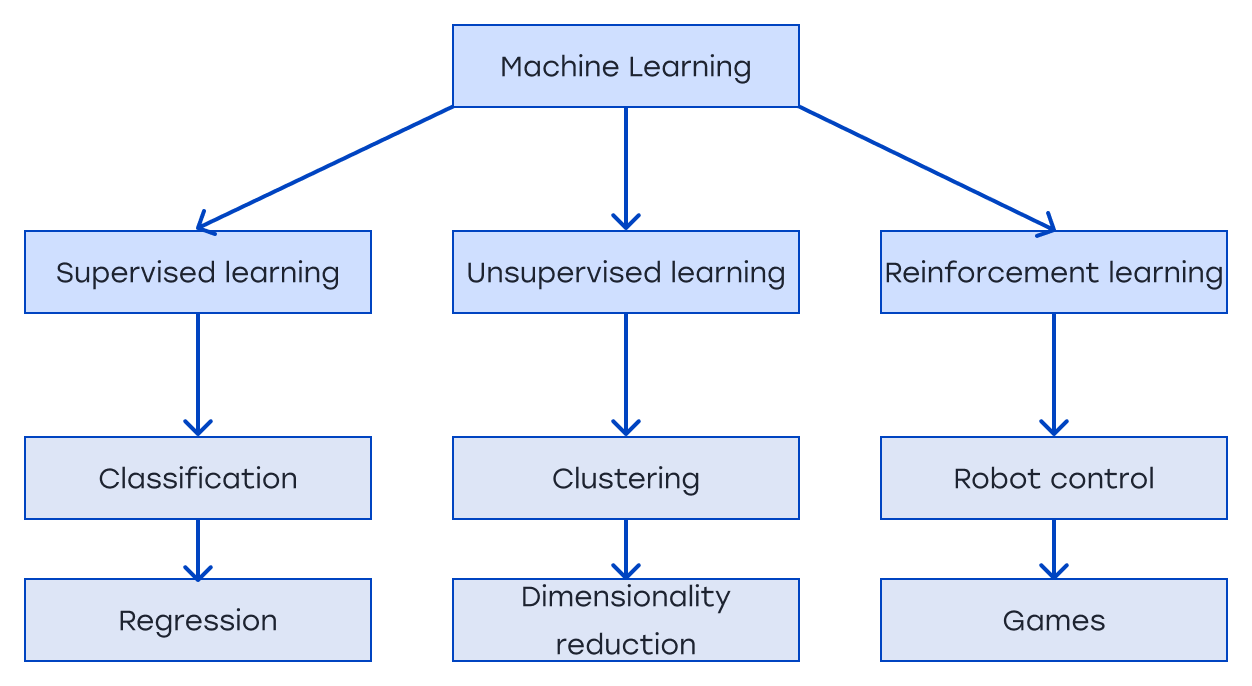Introduction to Machine Learning: what You Need to Know

Today, the volumes of information and data are growing rapidly. They hold the potential to extract valuable insights and make meaningful decisions. However, to use this data, we need to uncover hidden patterns and predict future events. This is where machine learning (ML) comes into play. Its essence lies in creating algorithms and models that can automatically extract knowledge from data and solve tasks or predict outcomes based on them. In this article, we will dive into the basics of machine learning.
Introduction to Machine Learning
Machine Learning (ML) is an Artificial Intelligence (AI) field that focuses on the development of algorithms and models capable of learning from data, making predictions, and making decisions without explicit programming.
Principles of Machine Learning
Machine Learning is based on several principles that ensure its functionality:
- Data. ML is built on the use of data. Training data provides the model with information about input features and their corresponding correct answers. The more diverse, high-quality, and representative the data, the better the model can learn, recognize patterns, and make accurate predictions on new data.
- Model. It represents an algorithm or a mathematical function that transforms input data into output. The choice of model depends on the task and the type of data. It can be linear, a decision tree, a neural network, etc. One of the key goals of machine learning is to create models that can provide accurate predictions for new data that were not used during the training process.
- Training. The training process involves fitting the model to the training data. The model analyzes the data, identifies patterns, and adjusts its internal parameters to minimize the error between its predictions and the correct answers. Training can be supervised (with labeled answers), unsupervised (without labeled answers), or reinforcement-based (with rewards or punishments). Instead of explicit programming, models gain knowledge from data and adjust their parameters to achieve performance.
- Automation. ML aims to automate processes and decision-making based on data, without the need for explicit human intervention. ML algorithms are capable of performing complex tasks with high speed and accuracy.
- Evaluation and Testing. After training the model, its performance needs to be evaluated on new data. This is done using a test dataset that the model has not seen during training. Evaluation is performed using metrics that measure accuracy, recall, F1 score, and other characteristics of the model. This allows assessing how well the model performs the task and determines the need for further refinement.
- Generalization. In ML, a model should be capable of making accurate predictions or decisions on new, previously unseen data. This property is called generalization. A good model is able to generalize knowledge, identify common patterns, and apply them to new situations.
- Regularization and Complexity Management. When a model becomes complex, there is a risk of overfitting, where the model adapts well to the training data but fails to generalize to new data. Regularization methods such as L1 and L2 regularization are used to control model complexity.

Differences between ML, AI, and DL
Machine Learning, Artificial Intelligence, and Deep Learning are closely related but have different characteristics:
Artificial Intelligence (AI) covers a broader range of technologies and methods aimed at creating intelligent systems capable of performing tasks. That requires human-like intellectual abilities. Machine Learning is one of the techniques used in Artificial Intelligence.
Machine Learning (ML) is a field that includes algorithms and methods that enable computer systems to learn from data and make predictions or decisions. Machine Learning is a subset of Artificial Intelligence.
Deep Learning (DL) is a subfield of ML that utilizes artificial neural networks with a large number of layers to extract high-level features from data. It is commonly applied to tasks such as image recognition, natural language processing, and automated decision-making.
Examples of Machine Learning Applications
Machine Learning is widely applied in everyday life and various industries. Let's explore a few examples.
In everyday life, we are familiar with voice assistants like Siri and Google Assistant, which use machine learning for voice recognition and understanding. Many smartphones also feature automatic facial recognition, allowing organization and classification of photos based on people and creating fun videos using this data. Another example of machine learning is the recommendation systems in online platforms like YouTube, IMDb, Netflix, Spotify, which offer personalized recommendations for movies, music, books, and more.

Machine Learning finds increasing use in the healthcare sector, such as disease diagnosis based on medical imaging or even voice data, including COVID, brain lesions, cancer, and other pathologies. It is also employed for real-time monitoring and prediction of patient conditions using wearable devices and sensors. Machine Learning contributes significantly to the development of new medicines and the search for potential medicines compounds.
The finance industry heavily relies on machine learning. Financial data analysis is used for predicting market trends and making investment decisions, detecting fraudulent transactions based on anomalies in customer behavior and historical data, as well as credit scoring and assessing the creditworthiness of customers based on their financial history and other factors.
Machine Learning plays a key role in the development of autonomous vehicles, enabling them to analyze the surrounding environment and make decisions based on sensor data.
In the industrial sector, machine learning is used for optimizing production processes, predicting equipment failures, and improving product quality.
Types of Machine Learning
What are the types of machine learning? Most tasks in machine learning can be divided into two types: supervised learning and unsupervised learning. In these methods, a "teacher" can be a programmer who sets rules and controls the algorithm's performance, but it is not mandatory. In the context of machine learning, a "teacher" can be any human intervention in the information processing process. In both cases, the algorithm is provided with input data that it must analyze and find patterns in. The main difference between supervised learning and unsupervised learning lies in the presence or absence of provided hypotheses that need to be tested or confirmed. There is also a third type – reinforcement learning, where a model learns to make decisions and perform actions in a specific environment to maximize a reward or accumulated utility. Let's take a closer look at these types.

Supervised Learning
Supervised learning is a type of machine learning where a model is trained based on labeled data, where each data example has a corresponding target variable or label. The model aims to find dependencies and common patterns between the input data and the corresponding output labels. Examples of supervised learning algorithms include linear regression, support vector machines, random forests, and neural networks.
Examples of tasks:
- Classification – determining the class membership of an object. For example, classifying emails as spam or not spam.
- Regression – predicting a continuous target variable. For example, predicting the price of a house based on its characteristics.
Unsupervised Learning
Unsupervised learning is a type of machine learning where a model is trained on unlabeled data without explicit target variables. Instead, the model seeks hidden structures, patterns, and groups in the data. Unsupervised learning algorithms are used for data clustering, dimensionality reduction, association analysis, and feature generation.
Examples of tasks:
- Clustering – grouping similar objects within the data. For example, segmenting customers based on their buying behavior.
- Dimensionality reduction – reducing the dimensionality of data while preserving important features and eliminating noise. For example, compressing images without significant loss of information.
Reinforcement Learning
Reinforcement learning is a type of machine learning in which a model learns by interacting with an environment and receiving feedback in the form of rewards or penalties. The model makes decisions and adjusts its behavior based on the received reward. It is actively used in robotics, games, and autonomous system control.
Examples of tasks:
- Robot control – training a robot to perform specific actions in its environment to achieve set goals.
- Games – training an agent to play games, such as chess or video games, to achieve the highest possible score.
Skills and Education Required for Machine Learning
Machine learning requires a deep understanding of algorithms and methods, as well as the ability to apply them in practice. Understanding programming is an essential part of working with machine learning, especially in programming languages such as Python or R, which are widely used in this field. Statistics knowledge and mathematical analysis helps in data analysis, selecting suitable models, and evaluating their effectiveness. Here are the key skills required to work as a machine learning specialist:
1. Programming
One of the most important skills for working with machine learning is programming. It allows you to implement and apply machine learning algorithms. The two most popular programming languages in the field of machine learning are Python and R. Python has a wide range of libraries and tools such as NumPy, Pandas, and TensorFlow, which simplify the development and experimentation with machine learning models. R is a powerful tool for statistical analysis and data visualization. Knowledge and experience with Python and R are essential skills for working with machine learning.
2. Statistics
Statistics helps in data analysis, model evaluation, and making statistically sound conclusions. Knowledge of basic statistical concepts such as probability distributions, statistical tests, and regression analysis allows for a deeper understanding of data and their relationships.
3. Algebra and Mathematical Analysis
Linear algebra, matrices, vectors, and operations with them are used in many machine learning algorithms and models. Knowledge of algebra allows for understanding and working with fundamental concepts such as scalar product, eigenvalues, and eigenvectors. Mathematical analysis includes differential and integral calculus, which can be useful for model optimization and gradient-based learning.
3. Probability Theory
Knowledge of basic concepts and methods of probability theory helps in building probabilistic models, estimating event probabilities, and working with probability distributions. It is necessary for understanding stochastic processes and the Bayesian approach in machine learning.
4. Natural Language Processing and Computer Vision
Natural Language Processing (NLP) is a branch of machine learning that deals with the analysis and processing of textual information, such as news, reviews, social media, etc. Working with NLP requires knowledge of algorithms and methods for tokenization, lemmatization, classification, sentiment analysis, and machine translation. These skills allow for analyzing and understanding natural language.
5. Computer vision
Computer vision is a field that deals with the analysis and interpretation of visual data, such as images and videos. Working with computer vision requires skills in image processing, pattern recognition, image segmentation, and image classification. Knowledge of computer vision algorithms and methods, such as convolutional neural networks and image processing techniques, enables solving various tasks related to visual data.
It is also worth noting that knowledge of the English language is essential for studying machine learning. Many courses and materials are available only in English, and it greatly facilitates learning machine learning.
The field of machine learning is rapidly evolving, and new methods and algorithms emerge over time. Continuous education helps to keep up with the latest trends, new algorithms, and tools, as well as to master advanced methods. Self-education, in turn, allows for exploring and experimenting independently, expanding understanding and depth of knowledge in the field of machine learning. Only through continuous education and self-learning can professionals adapt to the changing environment, apply cutting-edge methods and technologies, and achieve new heights in their careers.
Getting Started with Machine Learning
Starting the journey in machine learning can be challenging, but with the right approach and accessible resources, you can overcome difficulties and achieve success. Learn the basics of programming and statistics, explore self-learning resources, and don't be afraid to apply your knowledge in practice through project work. This will help you develop and enter the world of machine learning.

Let's go through the essential courses, books, and websites that can help you progress in machine learning.
Machine Learning books
- Mathematics for Machine Learning by Marc Peter Deisenroth, A. Aldo Faisal, and Cheng Soon Ong;
- Python for Data Analysis. A Complete Guide for Beginners, Including Python Statistics и Big Data Analysis ИЛИ Python for Data Analysis by Wes McKinney;
- The Hundred-Page Machine Learning Book by Andriy Burkov;
- Machine Learning For Absolute Beginners: A Plain English Introduction - Oliver Theobald;
- Machine Learning in Action by Peter Harrington.
A selection of 100 free books on Data Analytics.
Machine Learning courses
- Supervised Machine Learning: Regression and Classification | Coursera.org
- Machine Learning Foundations: A Case Study Approach | Coursera.org
- Complete 2022 Data Science & Machine Learning Bootcamp | Udemy
- Machine Learning Crash Course with TensorFlow APIs | Google
- Introduction to Machine Learning | Udacity
- Machine Learning With Python | IBM
- Machine Learning for All | Coursera.org
- Intro to Machine Learning | Kaggle
- Introduction to Artificial Intelligence | SkillUp
- Data Science: Machine Learning | edX
Machine Learning sites
- Kaggle is a platform where you can find suitable machine learning projects. On Kaggle, you can work with data, solve tasks, and gain experience. Additionally, Kaggle hosts ML competitions with a $100,000 prize.
- GitHub is a platform for hosting code and exploring and getting inspired by projects from other community members. It's a place to learn something new, find useful resources, and get inspired for future projects.
Professional Growth and Career in Machine Learning
Machine learning is one of the most in-demand and rapidly evolving fields in the realm of information technology. With the increasing amount of data and computational power, ML has become an integral part of many industries. What kind of jobs await a machine learning specialist?
Data Scientist
Data scientists analyze and interpret data, develop and apply machine learning models to extract valuable insights. They work on tasks such as prediction, classification, clustering, and optimization based on data. Deep knowledge in statistics, machine learning algorithms, and programming is necessary for a successful career as a data scientist.
Data Analyst
Data analysts study information, conduct research, and create reports and visualizations to facilitate data-driven decision-making. They use statistical methods and tools to analyze data and identify trends and patterns. Developing skills in SQL, statistics, and data visualization is key to a successful career as a data analyst.
Machine Learning Engineer
ML engineers develop and deploy ML models, create infrastructure for data processing, and implement models in real-world environments. They work with large datasets, optimize models, and deal with system scalability. Skills in programming, algorithms, and data infrastructure are required for a successful career as a machine learning engineer.
Machine Learning Researcher
Machine learning researchers focus on developing new algorithms and methods, conducting experiments, and publishing scientific papers. They contribute to the advancement of machine learning and the solution of complex problems. A deep understanding of mathematical foundations and ML algorithms, as well as active participation in the research community, are necessary for a successful career as a machine learning researcher.
Building a successful career in machine learning requires continuous learning and development. Here are a few tips to help you in this process:
- Continuous learning. Machine learning is a field that is constantly evolving. Be prepared to update your knowledge and learn new methods and tools. Continuously expand your skills and stay up-to-date with the latest trends in machine learning.
- Project involvement. Participating in real-world projects allows you to apply your knowledge in practice and gain practical experience. Projects will help you improve your programming, data analysis, and teamwork skills.
- Networking. Connect with other professionals in the machine learning field. Attend conferences, meetups, and forums to exchange knowledge, experience, and ideas. Networking will expand your opportunities and provide you with new perspectives.
- Building a portfolio. Create a portfolio showcasing your projects, research, and achievements in machine learning. This will help you demonstrate your skills and accomplishments to potential employers or clients.
Professional growth and career in machine learning require persistence and a continuous desire for self-improvement. Don't be afraid to take on new challenges, continue learning and developing, and you will be able to succeed in this exciting field.
This article covered the main types and principles of machine learning, discussed key skills required for working in the ML field, provided a selection of essential resources to help aspiring professionals dive into the field of machine learning, and offered some tips for starting a career.





